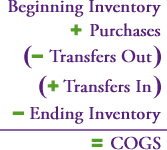Cost of goods manufactured refers to the cost of goods brought to completion, whether they were started before or during the current accounting period.
Must have to know to solve the problem:
=> Cost of beginning inventory
=> Cost of goods manufactured
=> Cost of goods available for sale
=> Cost of ending inventory
=> Cost of goods sold
Beginning inventory:
Must have to know to solve the problem:
=> Cost of beginning inventory
=> Cost of goods manufactured
=> Cost of goods available for sale
=> Cost of ending inventory
=> Cost of goods sold
Beginning inventory:
Beginning inventory is the recorded cost of inventory in a company's accounting records at
the start of an accounting period. The beginning inventory is the recorded cost
of inventory at the end of the immediately preceding accounting period, which
then carries forward into the start of the next accounting period.
Beginning inventory is an asset account, and is classified as a current asset. Technically, it
does not appear in the balance
sheet, since the balance sheet is normally created as of a specific date, which
is normally the end of the accounting period, and so the ending inventory
balance appears on the balance sheet. However, as just noted, beginning
inventory is the same as the ending inventory from the immediately preceding
accounting period, so it does appear
in the balance sheet as the ending inventory in the preceding period.
The primary use of beginning inventory is to
serve as the starting point of the cost
of goods sold calculation for an
accounting period, for which the calculation is:
Beginning inventory
+ Purchases during
the period
- Ending inventory
= Cost of goods sold
A secondary use of
beginning inventory is for the calculation of average
inventory, which is used in the denominator of a number of performance
measurements, such as the inventory turnover formula. These measurements can
use just the ending inventory figure, but using the beginning and ending
inventory balances to derive an average inventory figure for an accounting
period tends to generate a smoothing effect that counteracts an unusually high
or low ending inventory figure.
The cost of goods manufactured:
The cost
of goods manufactured is the cost assigned to units either
completed or still in the process of being completed at the end of an
accounting period. This cost is most useful when disaggregated into its
component parts and examined on a trend line. By doing so, you can determine
the costs that a company is incurring over time to produce a certain mix and
quantity of units. The concept is useful for examining the cost structure of a
company's production operations.
Cost of goods available for sale:
Cost of goods available for sale is the total
recorded cost of beginning finished goods or merchandise inventory in an
accounting period, plus the cost of any finished goods produced or merchandise
added during the period. Thus, the calculation of the cost of goods available
for sale is:
Beginning sellable
inventory
+ finished goods produced
+ Merchandise acquired
The cost of any
freight needed to acquire merchandise (known as "freight in") is
typically considered a part of this cost.
Ending inventory:
Ending inventory can be considered either the
total unit quantity of ending units of inventory in stock at the end of an
accounting period, or the total valuation of that inventory at the end of an
accounting period. The ending inventory figure is needed to derive the cost of
goods sold, as well as the ending inventory balance to include in a company's
balance sheet.
The cost of goods sold:
The
cost of goods sold includes those costs attributable to the products or
services sold by a business. It is usually separately reported in the income
statement, so that the gross margin can also be reported. Analysts like to
track the gross margin percentage on a trend line, to see how well a company's
price points and production costs are holding up in comparison to historical
results.
One
way to calculate the cost of goods sold is to aggregate the period-specific
expense listed in each of the general ledger accounts that are designated as
being associated with the cost of goods sold. This list usually includes the
following accounts:
§ Direct
materials
§ Direct
labor
§ Factory
overhead
§ Freight
in and freight out
The
list may also include commission expense, since this cost usually varies with
sales. The cost of goods sold does not include any administrative or selling
expenses.



No comments:
Post a Comment